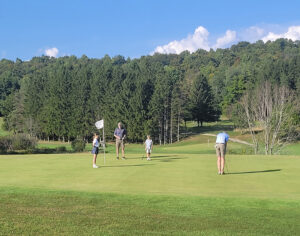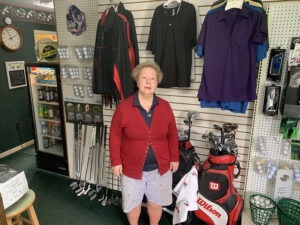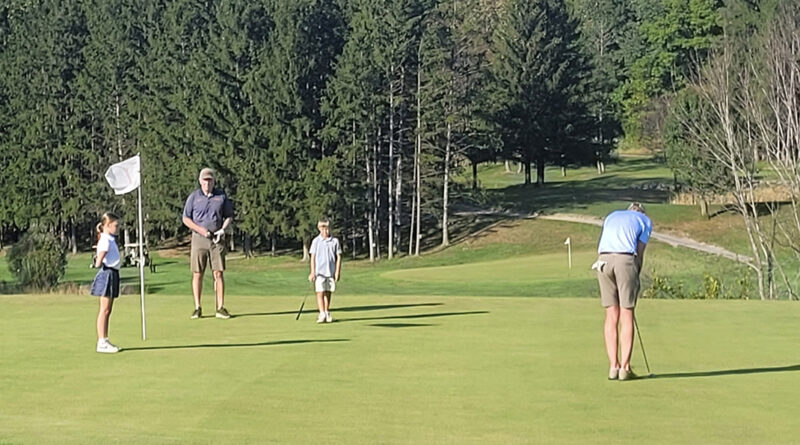A Retirement Life: Running a Golf Course
A retired Auburn firefighter and his wife, a computer programmer, bought Pearl Lakes Golf Course in Skaneateles 25 years ago as a retirement business — they still run it today
By David Figura

Angelo and Mary Tozzi’s retirement years have been dominated by one thing — the Pearl Lakes Golf Course and Driving Range in Skaneateles.
For the past 25 years, Angelo, 75, a retired Auburn firefighter and Mary, 76, a retired computer programmer, have owned and maintained the nine-hole, course on Old Seneca Turnpike (County Route 133).
The public course offers seven, par-three holes and two par-four holes. With a cart, one can easily finish in about an hour and a half, making it attractive for golfers looking for a quick, challenging round. It costs $23 to play nine holes with a cart; $33 for 18.
“We get people coming up from New York City and other places and when we tell them the prices, we often hear, “And that’s all?” Angelo said.
On a recent weekday early May afternoon, Joe Adams, 77, and Mike Zales, 75, both of Camillus, were hitting balls on the driving range.
“I’ve been coming to Pearl Lakes for years,” Adams said. “I like the course because it’s usually not that crowded and there’s not too many local driving ranges open now.”

The course was built in 1993 by Chris Staples of Skaneateles. It covers more than 59 acres in a picturesque setting with rolling hills and forest. It was originally designed by renowned golf architect, Robert Trent Jones Jr., according to golfandtravel.com.
When the course first opened it had seven small ponds. Staples named the course after his wife, Pearl, and added the word “Lakes” because of the ponds.
Since then, only three ponds remain. The others were filled in with “tons of sand” and now sport cattails, Angelo said.
How did a firefighter and computer programmer come to own a golf course?
Back in the late 1980s, the Tozzis were both working full-time. Angelo as a firefighter; Mary as a computer programmer for Continental Information Services in Syracuse.
Angelo also had a part-time job, helping a friend who owned Byrn’s Trophies and Sports in Auburn.
“I was helping him build trophies when I wasn’t fishing or hunting,” he said.
Eventually, the store owner moved to Florida and the Tozzis bought the business. Mary, who tired of the daily commute to Syracuse (particularly in the winter), quit her Syracuse job and began working full-time at the trophy shop. Angelo, with his flexible firefighter hours, worked part-time at the business.

Dan Soules and Mark Dunn, co-owners of Cranebrook Hills Golf Course (just west of the city of Auburn) were frequent customers at the trophy shop. Soules made the Tozzis aware that Pearl Lakes was for sale and suggested that owning it would be “a nice, little nest egg” for them in retirement, giving them the winters off.
“We came here with some friends and went golfing. Everyone was smiling, laughing and we had a real good time,” Mary remembered.
Shortly after, the couple decided to sell the trophy shop, which they had been running for 13 years and bought Pearl Lakes for $300,000.
The couple soon realized that owning a golf course was not an easy, leisurely business venture.
“There was nothing here. We had to buy all the golf carts. The greens looked like they belonged in a freaking museum. There was no [adequate] equipment to mow the fairways or to pick up the balls on the driving range,” said Angelo, who retired from the fire department in 2003 to dedicate all his time to the course.
Initially, the Auburn couple got assistance from their two sons in running Pearl Lakes, but their help ended. They’ve also had friends and part-time workers helping out over the years. But for the majority of the time — and even today — it’s Angelo and Mary who keep things running.
Weather permitting, each year the course and driving range opens annually in March and stays open seven days a week, often through Thanksgiving.
Angelo mows the fairways, maintains the greens and does whatever else needs to be done to keep the course in playing shape.
Twice over the years he’s had to pull golf carts out of the ponds, the result of young, inexperienced drivers. He’s also had to apply to the state Department of Environmental Conservation for a nuisance permit to get rid of beavers that have come on the course from an adjacent swamp.
“A friend of mine who is a trapper helped out,” he said. “This spring he got a 48- and a 54-pounder.”
What’s the most important thing about maintaining a golf course?
“In my opinion, the greens are more important than anything else,” Angelo said. “That’s our lifeblood right there. That’s why I have to keep them green and looking nice. They keep us in the green.”
Mary tends the clubhouse, taking in greens and cart rental fees, along with handling all the bookkeeping. She also runs the adjacent driving range, driving the machine that picks up the balls. She then brings the balls back to the clubhouse, washes them and puts them out in baskets for golfers to use.
It all makes for long days, particularly during the warm, busy summer months. At times, Angelo stays overnight in the clubhouse on weekends, sleeping in a recliner in the back office.
Business the past two years has picked up and the course continues to be profitable, Mary said.
Not surprising, though, the couple who got into the golf course business partially because of their love of the game rarely, if ever, have time to golf themselves. And after 25 years, they’re looking to sell Pearl Lakes.
“It’s hard to walk away,” Angelo said. “We’re both getting up there in age. I’d like to see it remain a golf course. But it’s time.”
Angelo then paused, looking out on the course with pride.
“Most everything you see here was from us,” he said.

